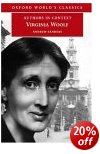literature, politics, philosophy, art, feminism, criticism
The Authors in Context series examines the work of major writers in relation to their own times and the present day. This volume sets Virginia Woolf in the social, cultural, and political context of the period between 1900 and 1940, then looks at how we see her work now, from the perspective of the twenty-first century. Michael Whitworth starts with a biographical sketch of her life. He certainly knows all the details, and his outline might well propel readers who don’t already know about the troubled family life, the periods of creativity sandwiched between bouts of insanity, and the bohemian lifestyle of the Bloomsbury Group towards her famous Diaries and Letters for further revelations about this remarkable woman and groundbreaking modernist writer.
 Next comes a chapter providing the political and social background to the period 1900—1940, with its important developments in women’s rights, the rise of socialism, and the gradual erosion of the British Empire. It also contains some interesting reflections on the changing nature of ‘the family’ and ‘the household’ – particularly in relation to the employment of servants.
Next comes a chapter providing the political and social background to the period 1900—1940, with its important developments in women’s rights, the rise of socialism, and the gradual erosion of the British Empire. It also contains some interesting reflections on the changing nature of ‘the family’ and ‘the household’ – particularly in relation to the employment of servants.
For those interested in the creative process, Whitworth reveals how Virginia Woolf’s method of composition started by her thinking about what she wanted to say, then articulating it in verbalised sentences, then speaking the sentences aloud. Following this, she then wrote out what she had composed in longhand, typed what she had written down, then subsequently revised it – sometimes several times over.
He deals well with problem topics, such as Woolf’s anti-semitism (even though she was married to Leonard Woolf, who was Jewish in origin if not in practice) and he knows enough about her to trace the gradual rise in self-awareness about this issue in her writing.
There’s a good chapter on what he calls The Writer and the Marketplace – that is, the writer’s financial relationship with book production and publishing – both of which Woolf practised professionally.
There are some fascinating pages which steep the reader deep into the literary and ideological culture of the period, and Whitworth is a rigorous guide to the new literary techniques which Woolf was pioneering.
He deals with the philosophic questions which permeate her work: the relationship between art and life; the nature of human perception; plus subjective and objective notions of time.
There are in-depth analyses of Mrs Dalloway, Night and Day, and The Waves, and he puts his finger on one of her most important strengths – showing the political issues in daily life:
The great strength of Woolf’s narrative method is that it allows her to present social issues in their psychological aspects; long before anyone voiced the slogan ‘the personal is the political’, Woolf identified the connection. In Night and Day, she takes the idea that the ‘professions’ might include ‘marriage’ and ‘living at home’, and uses it as the bridge between personal and public
The final part of the book looks at adaptations of Woolf’s work for the screen. This includes films of To the Lighthouse, Orlando, and Mrs Dalloway, as well as the recent version of Michael Cunningham’s The Hours. Whitworth persuasively argues that we should not expect these versions to be slavishly accurate. They are versions or interpretations which allow us to re-interpret the original or see it in a new light.
This is a book which can be read in two ways. For those who already know Woolf and her works it explores the important social, artistic, and intellectual themes which she examines, and for those who don’t, it will act as an excellent introduction. It is certainly a critical study which any lover of Woolf’s work will not want to miss.
© Roy Johnson 2005
Michael Whitworth, Virginia Woolf: Authors in Context, Oxford: Oxford University Press, 2005, pp.268, ISBN: 0192802348
More on Virginia Woolf
Virginia Woolf – web links
Virginia Woolf – greatest works
Virginia Woolf – criticism
More on the Bloomsbury Group